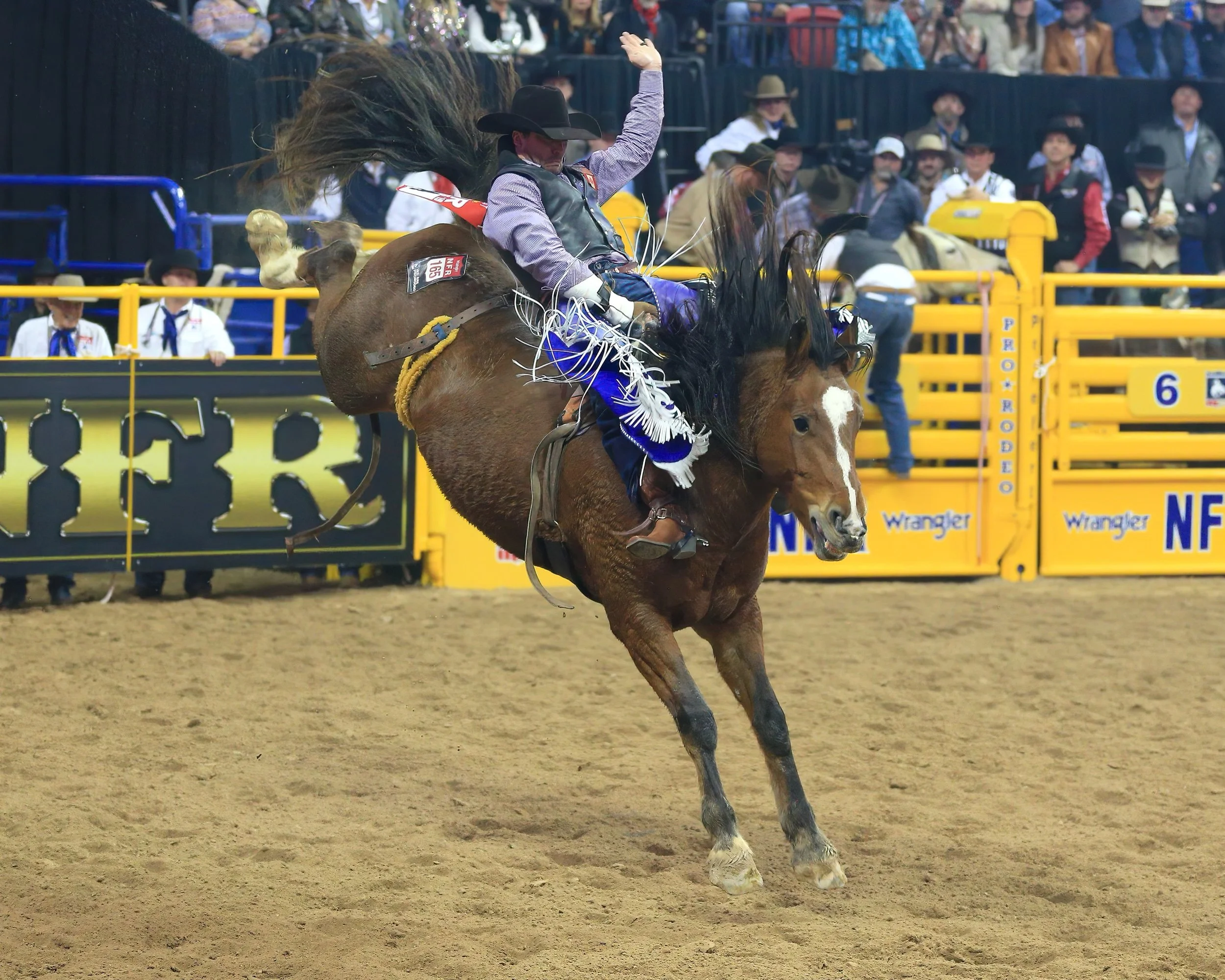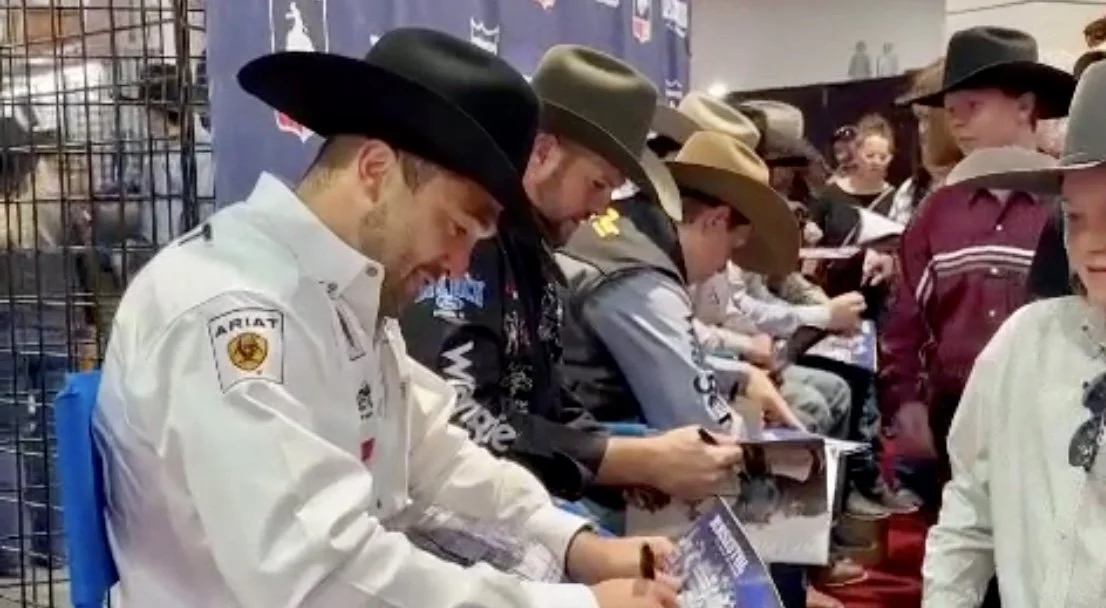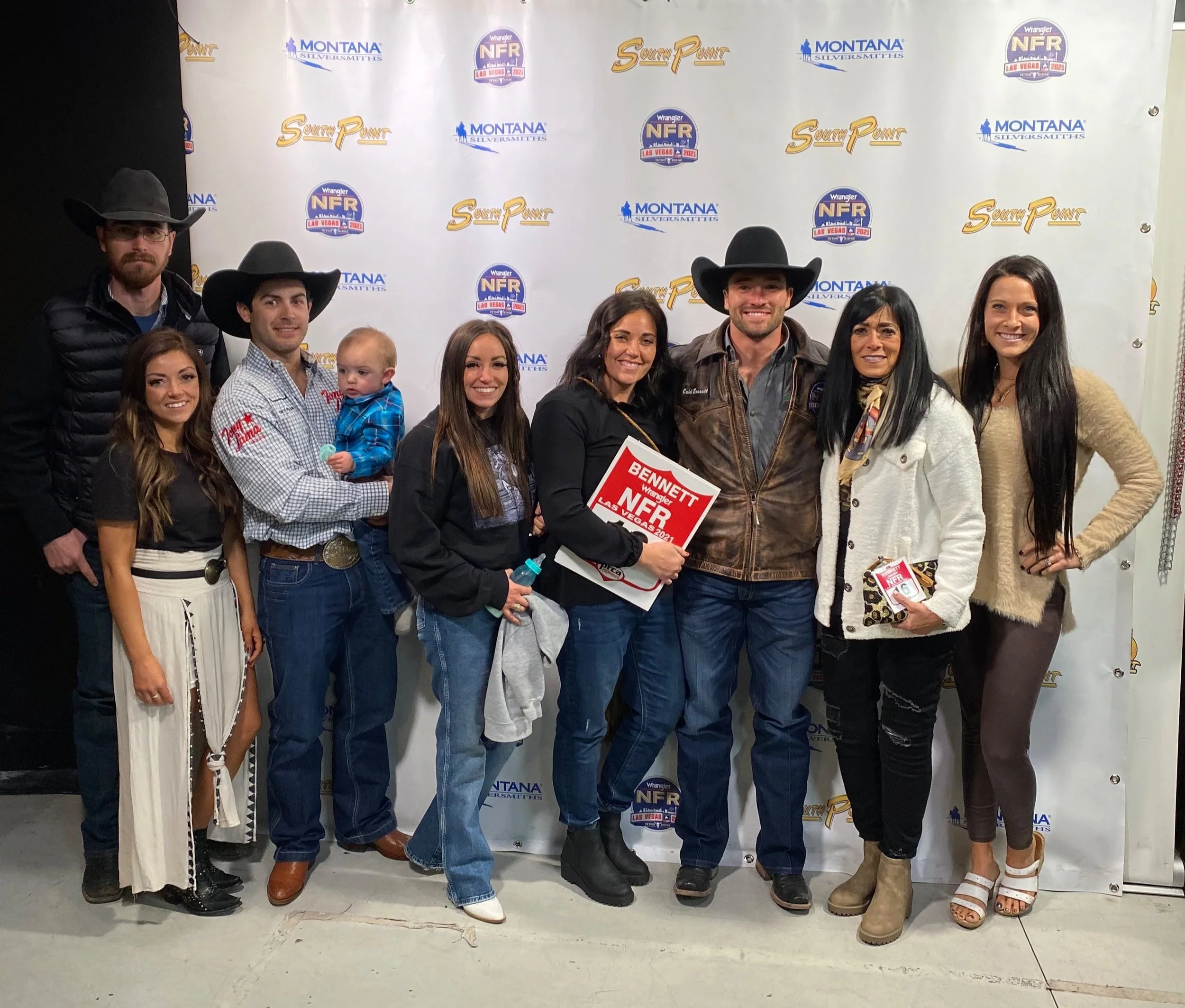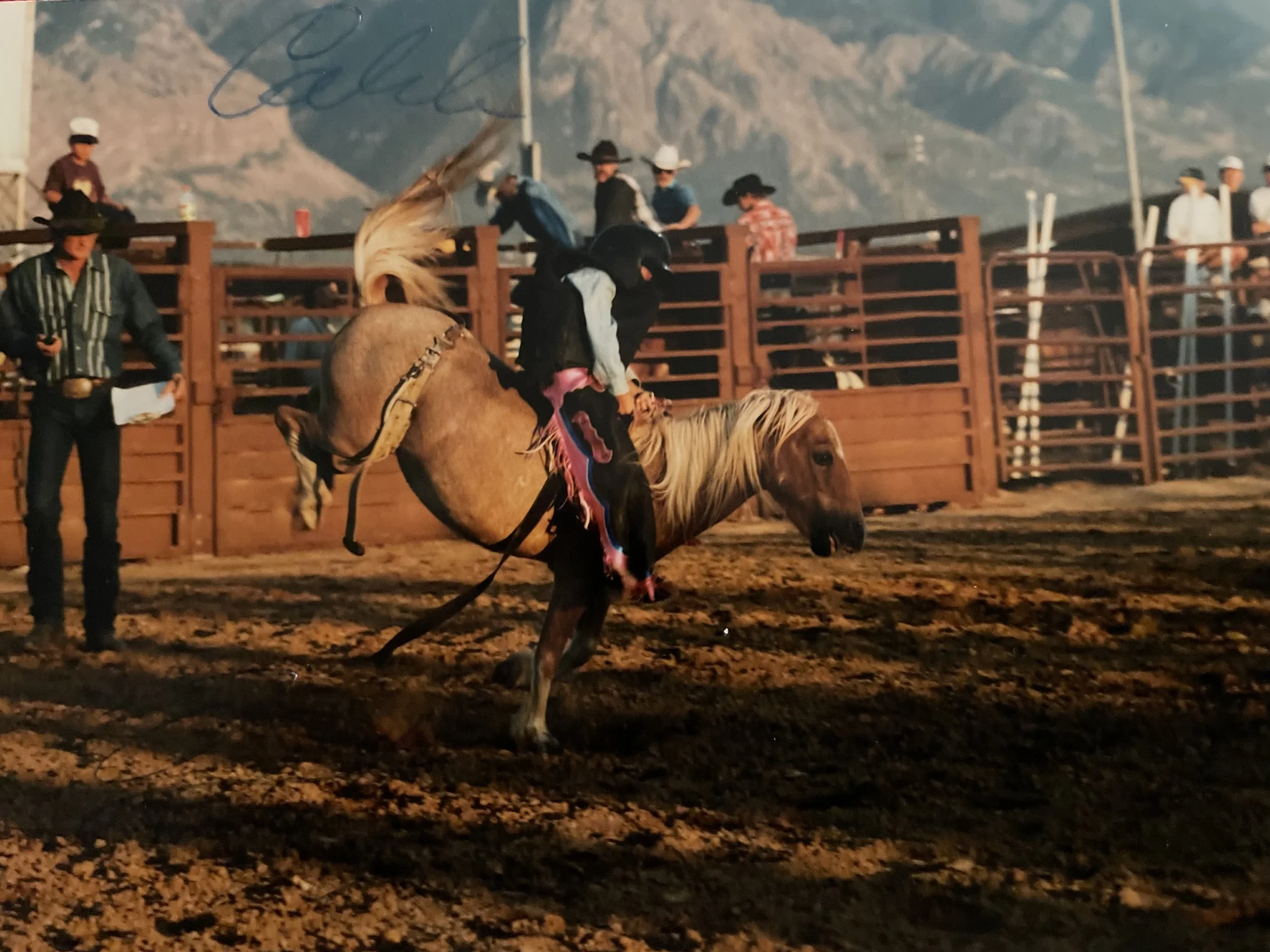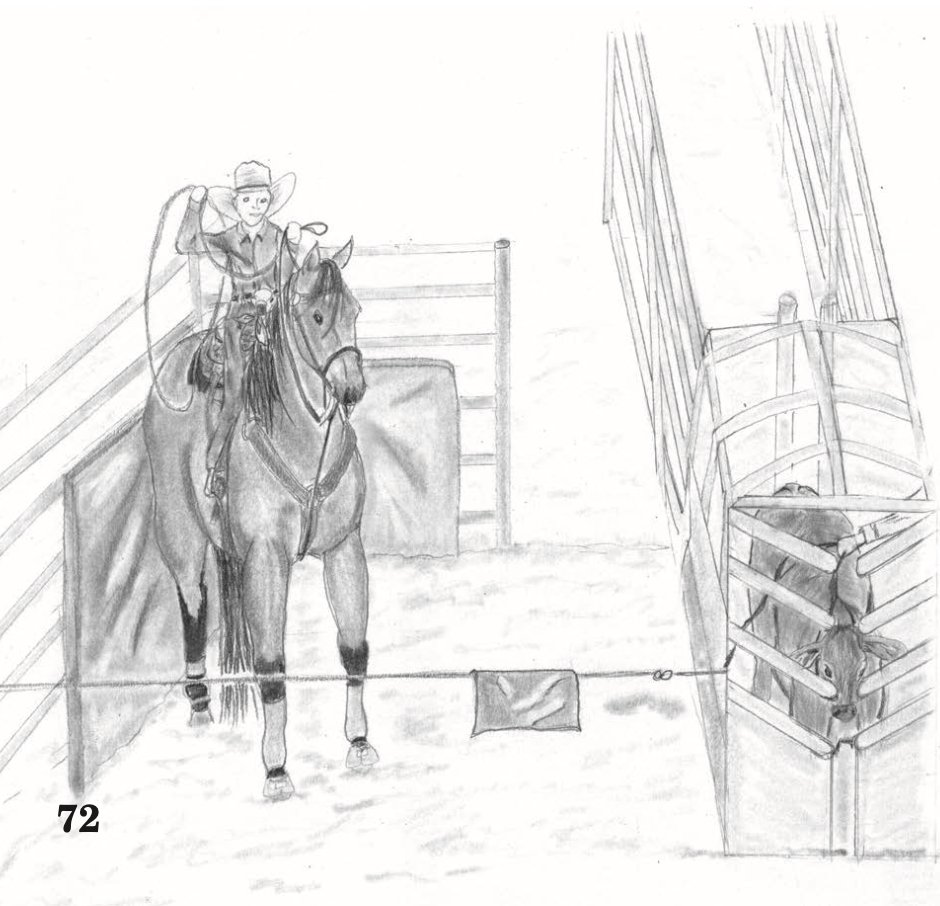Cowkids Only - December 2023
December 2023
Brought to you by The Bell Mare Book Company
Ask a Pro:
Caleb Bennett
Caleb Bennett is a 10-time National Finals Rodeo bareback rider and has won more than $1 million throughout his career. No one gets an NFR experience quite like a bareback rider. Can you imagine watching the opening ceremonies of the NFR from the back of the bucking chutes with a bareback horse standing in front of you?!
Caleb was kind enough to give us a contestant’s view of what the NFR looks and feels like from the back of the bucking chutes, as well as some awesome advice for rodeo kids! Hope you love reading all about the NFR from a bareback rider’s perspective!
Ask a Pro:
NFR Bareback Rider Caleb Bennett
Question: Describe what it is like on the back of the bucking chutes during the opening ceremony at the NFR?
Caleb’s Answer:
My first night at my first NFR, I remember standing on the back of the bucking chutes and not being able to wipe the big smile off my face. I remember my traveling partner looking over at me as the contestants were finishing the grand entry and saying, “You better wipe that smile off your face and get serious! You have a horse to ride!” That night and every night I got to step on the back of those yellow bucking chutes after that, is an experience I can’t even put into words. That feeling is literally what my dreams are made of. I remember being a teenager and watching the guys at the NFR and thinking I wanted to be like them one day, and then suddenly I was. That feeling is something I will never forget or take for granted.
Question: How do you overcome your nerves and all the distractions of the NFR?
Caleb’s Answer:
Get comfortable being uncomfortable. Whether you are in the rodeo arena or the classroom, anytime you can push yourself out of your comfort zone, you are growing yourself mentally. I have been to 100 rounds at the NFR and I have been nervous every single time I step up onto the bucking chutes. But, I have learned how to let my nerves benefit me, instead of distracting me. When you want something so badly, you are always going to have nerves. If you have put in the work beforehand to win, then you can be confident that those nerves are actually just you being excited to win. When I feel my nerves coming on, I close my eyes and picture myself making a perfect ride. Matching my horse jump for jump. Seeing a good score on the scoreboard. I picture myself winning. If I know I have worked hard to prepare myself for my ride, I can just smile at my nerves knowing they are really just me being excited to win.
Caleb signing autographs during the NFR
Question: What does a typical day in Las Vegas look like for you? How do you take care of yourself during those long days?
Caleb’s Answer:
I think finding a balance is important. I have found that getting up at my normal time and going to bed as close to my normal time as possible really helps me stay healthy during the NFR. I schedule all of my interviews and autograph signings in the mornings and then spend the afternoons getting prepared for the rodeo. I like following what I call an 80/20 rule. That means, 80 percent of the time I am doing something that betters myself - getting good sleep, working out, eating healthy, imagining my rides, practicing, etc. The other 20 percent of the time, I am having fun, eating ice cream, spending time with friends, etc. If you can go to your junior rodeos and spend 80 percent of your day practicing, competing, eating healthy and getting good sleep, you should spend the other 20 percent having fun! Finding your balance of time spent making yourself better and time spent enjoying the rodeo experience is going to make you a better competitor, whether you are at the NFR or a junior rodeo.
Question: What does it feel like to win a round and get to accept your buckle on stage in front of your fans, friends and family? How do you overcome the times you don’t win?
Caleb’s Answer:
My family has always been my biggest supporters, so to be able to stand on the biggest stage in the sport of rodeo with them and realize that we accomplished this together, is the most humbling feeling you can imagine. You realize that all of the hours you spent practicing and preparing yourself to get better have paid off and it just fuels your motivation to keep working so you can win again. On the nights I don’t win, I like to follow the rule of the three Fs.
Figure out what I did wrong. I will watch a video or ask someone I trust what I did wrong.
Fix it. I decide how I am going to fix the problem on my next ride.
Forget it. Once you know what the mistake is and how you are going to fix it, put it behind you and start focusing on the next rodeo. When things aren’t going your way, don’t focus on past failures. Focus on where you are going and where you want to go.
Question: If you could get in a time machine and tell your younger self something, what would you say?
Caleb’s Answer:
Success does not come by chance. True success is a result of hard work that no one sees or notices. When I was younger, I tended to make excuses as to why I couldn’t practice. I was too tired, or I wanted to hang out with my friends, etc. If you truly want to win at the sport of rodeo, you can’t make excuses to keep yourself from doing things that make you better.
Caleb Bennett at age 8
Caleb grew up in a rodeo family and says he couldn’t have accomplished everything he has without the support of his family. He is pictured here riding a bareback horse in Ogden, Utah at the age of 8.
Question: What is your favorite thing to read?
Caleb’s Answer:
I have read the book, “With Winning in Mind” four or five times now. It is about an Olympic shooter and how he learned to handle pressure and overcome failures. The book taught me so much about the power of positive thinking. In order to be successful, you have to fill your mind with positive thoughts and not let negative comments - from yourself or others - get into your brain.
Cowkid Devotional
By High Call Ministries Pastor, Kelly Cronkhite
Kelly is not your typical pastor. He’s a Jesus-loving cowboy, rancher and roper.
Imagine you are watching over a herd of cattle at night. It’s December and probably cold enough to notice your horse’s breath. You are a little tired and hungry, but you can’t take your eyes off the herd because it is your job to protect them and keep them safe. Suddenly, an angel of the Lord appears and tells you the greatest miracle of all time has been born in a barn and you and your fellow herdsmen are going to be the first people to see Him besides His parents. I don’t know if the shepherds were horseback and I know they were watching over sheep and not cattle, but I still can’t imagine what they were thinking or feeling when they heard about Jesus being born. What about the animals in the barn? Do you think they realized who the baby sleeping in their feed bunk actually was and what He would do for the world? I don’t think it is a mistake that God first announced the birth of Jesus to shepherds and chose a barn for His birthplace. God could have chosen a king or queen to be the first person to meet Jesus. He could have chosen a church, temple or palace for Jesus to be born in. But, He didn’t. He chose shepherds tending sheep in the middle of nowhere and a barn full of animals. I think by doing this, God was showing us that Jesus is unlike any other king. Jesus is available to anyone who believes in Him. Jesus is not just for the important, rich, nice, smart, etc. He came to earth for all believers. He came for me and you. All we have to do is believe in Him and that He paid for our sins through his death on the cross so we could receive the only gift in life that really matters - salvation. This is what Christmas is really about. The wonderful gift that Jesus gave to each one of us through his birth, death and resurrection to be with His father in Heaven.
NFR Trivia Break
What contestant has won the most PRCA world championships?
Keep reading to find the answer!
Horse Care Tip of the Month
By Equine Veterinarian Zach Bruggen
Is it cold where you live? Winter has definitely arrived where I live! Here are some tips for keeping your horses healthy and comfortable through the winter months:
Watch them carefully to make sure they don’t become dehydrated. As the weather gets colder and the grass dies, we switch our horse’s diet to mostly hay. Hay is not a naturally hydrating food like grass because it is does not have a lot of moisture in it. Think about when you eat watermelon. You probably aren’t thirsty afterwards because there is a lot of water in watermelon so it helps you stay hydrated. That’s what grass is like to horses. Hay is more like eating a dry cracker. It has very little water (if any) in it and if your horse doesn’t drink enough to make up for the dry hay, they can colic. Here are some tips to get your horse to drink more water:
Always make sure they have plenty of fresh, clean drinking water and that it isn’t frozen
Add 1 tablespoon of salt or electrolytes to their feed daily
Put a white salt block in their pen
If you feed a pelleted feed and/or alfalfa cubes, water them down until they look like oatmeal to get extra water in your horse every day
Products like Zesterra or NutraBac pH can help increase thirst and encourage the horse to drink more
Most horses do just fine in the cold without blanketing. However, if the temperature is below freezing, it is windy and/or raining and snowing, they might need a blanket. When the weather is a combination of wet, windy and cold, horses get much colder than when it is only one of those conditions. Providing shelter for your horse to block the wind and rain and/or putting them in a waterproof blanket until the weather improves, can help them stay warm. It is important to monitor your horse and make sure they are staying dry under their blanket. A wet blanket can actually make them more cold than not wearing one at all.
If you keep shoes on your horse through the winter, snow and ice can get packed into your horse’s feet, which can be uncomfortable. Pick their feet out every day and spray the bottoms of their hooves with cooking spray to help keep the snow and ice from building up. You also can talk to your farrier about putting snow pads on your horse during the winter months if you live in an area that gets a lot of snow.
Cold + Wind + Rain = Brrrr!
Most of the time, horses can handle cold temperatures just fine. However, if the weather is cold, windy AND raining, horses need shelter and/or a waterproof blanket to stay warm.
NFR Trivia Break Answer
What contestant has won the most PRCA world championships?
Trevor Brazile. He won 26 world championships during his professional rodeo career. Trevor won gold buckles for the all-around, tie-down roping, team roping and steer roping.
Exercise of the Month
By Logan Corbett, with Champion Living Fitness and strength coach for many professional rodeo athletes
Do you have trouble flanking bigger calves or goats? Do you struggle to catch when you have to drop a coil or two? Would you cover your sheep, calves or steers better if you were just a little stronger? If you answered yes to any or all of those questions, this month’s classic exercise is a good one for your workout program. A push-up is a pressing exercise that is great for making your chest, shoulders, upper back and arms stronger. I would guess you have probably done a push-up before, but it is important you do them correctly to truly improve your strength. To correctly perform a push-up:
Start with your hands shoulder-width apart.
Set your feet hip-width apart. There should be a straight line between your heels, hips and shoulders.
Look down at the ground directly in front of you - your neck should be straight.
Before you start to lower yourself, pretend you are twisting a lid off a tight jar. Feel the pressure in your hands rotating outwards. This engages your back muscles and helps you control the movement to make it more effective.
Lower down slowly and keep your elbows in close to your sides. The gap between your arm and armpit should disappear.
Pause just before your body touches the ground and then push back up to your starting position.
Be careful not to let your hips sag down or raise too high throughout the exercise.
If push-ups are too difficult for you to do correctly, try doing them on your knees instead of with your legs extended all the way out. Keep the same form throughout your upper body as you would with a regular push-up. You also can do push-ups on your fists instead of with your hands flat on the ground if the exercise hurts your wrists. With all exercises, including push-ups, it is better to do a few correct exercises than a bunch of incorrect ones. Start doing a few correct push-ups each day, but stop before your body gets too tired to do them the right way. The next day you can do one more than the day before and keep building from there.
NFR Fitness Challenge
Don’t just sit on your couch and watch the rodeo! How about a push-up challenge? Every time a cowboy scores above 90 points in a roughtstock event or a cowboy or cowgirl breaks an arena record in a timed event, do 5 to 10 push-ups depending on your strength. Keep your form correct! Watch the video below of 10-time NFR qualifier, Caleb Bennett performing a correct push-up.
Rodeo Word of the Month:
Barrier
Barrier
The barrier is a rope system that crosses in front of the horse and attaches to the calf or steer’s neck. The calf or steer must break free from their portion of the barrier before the horse can come through their barrier. If the horse and contestant go through their barrier first, a penalty is applied. A barrier is designed to give the calf or steer the advantage over the cowboy or cowgirl. Barriers are used for timed events like breakaway roping, steer wrestling, tie-down roping, steer roping and team roping. This illustration is from our new chapter book, “Short Go and the Junior Rodeo Trail.” In this book for elementary-aged readers, Max and Short Go compete in the breakaway roping at a junior rodeo. The rope in front of Max and Short Go is the barrier.
Rodeo Math Problem of the Month
At many rodeos, cowboys can win money in each round and in the average. The average is either their times or scores from each round added together. In the timed events, the lowest average time would be the winner. In the roughstock events, the highest scoring average would be the winner. If bareback rider Caleb Bennett was 80 points in the first round, 84 points in the second round and won the short go with a 91-point ride, what would his total in the average be? Would that be high enough to beat his competition, Logan Corbett who was 245 points?
Reading Comprehension Problem of the Month:
NFR History
Charmayne James is a famous barrel racer from Clayton, New Mexico. Charmayne and her little bay horse, Scamper, were unlike any other barrel racing duo the NFR has ever seen. The pair won 10 straight world championships from 1984 to 1993 and six NFR average titles. Their most memorable run was from the 1985 NFR - the first year the rodeo was held in Las Vegas. As Scamper came up the alley, he caught his bridle on a gate and broke it! Fifteen-year-old Charmayne never hesitated and completed her run without the bridle, winning the round and helping her win her second world championship. Charmayne became the first barrel racer to ever win more than $1 million and the first woman to earn the number 1 back number at the NFR.
Was Scamper a big horse?
How many world championships did Charmayne and Scamper win in a row?
How old was Charmayne when she made her bridleless run on Scamper?


